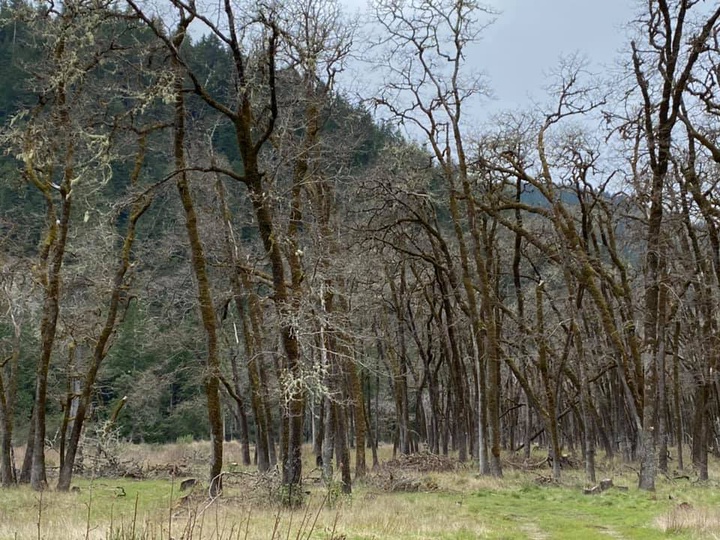Jessica Cejnar / Wednesday, May 5, 2021 @ 1:45 p.m. / Community, Tribal Affairs
'We Want to Continue to Steward This Land'; Tolowa Dee'-Ni Representatives Tell Why Mvs-yee-se’-ne (Pappas Flat) is Special

Tolowa Dee-ni' Nation citizens gather acorns from this Oregon white oak stand at Mvs-yee-se'-ne. Photo courtesy of Suntayea Steinruck.
Previously:
###
For some, Pappas Flat is one of countless remote places in the Smith River National Recreation Area — a dot on the map across the river from Gasquet.
To the Tolowa Dee-ni’ Nation, the 40-acre site with its 15-acre Oregon white oak woodland is Mvs-yee-se’-ne, where they gather food, basketry materials and other resources. And for centuries — until contact with non-native settlers — it was home.
“It is a traditional village site and a culturally significant landscape,” tribal chairwoman Leann McCallum told the Wild Rivers Outpost on Monday. “The Tolowa Dee-ni’ occupied this area until contact when the land was homesteaded. Most notable is the white acorn grove that our Tolowa ancestors cultivated. They would attend to the land and make sure everything was good to go, and it’s still there today.”
Today, Mvs-yee-se’-ne is on the National Register of Historic Places and its management is part of a part of a collaboration between the Six Rivers National Forest, the Tolowa Dee-ni’ Nation and Elk Valley Rancheria. According to McCallum, the partnership’s goal is to document and preserve the area’s cultural features as well as to remove invasive species such as Scotch and French broom and Himalayan blackberry.
An April 27 joint news release from three partners drew attention to recent vandalism and illegal activity in the area. These have increased over the last year and include people driving vehicles through the oak grove, racially offensive graffiti, disturbance to archeological resources, the dumping of trash and human waste and the cutting down of live white oaks, McCallum said.
“The USFS allows the cutting of firewood on its lands,” she said, “but cutting live trees, especially these protected ones, is illegal and unnecessary.”
According to Cynthia Ford, the Tolowa Dee-ni’ Nation’s habitat and wildlife program manager, no one is ever caught in the act because it’s so remote. She said Tolowa Dee-ni’ Nation staff discussed the possibility of putting up game cameras to monitor the site, but decided against it at this time because of the challenging public lands process.
Though the tribe isn’t pursuing the possibility of setting up cameras at Mvs-yee-se’-ne, there are some short-term and long-term responses they and the USFS will take. These include cleanup of the vandalism and replacement and reinforcement of barriers and increased law enforcement, McCallum said.
The Tolowa Dee-ni’ Nation is also planning educational features to inform the community of Mvs-yee-se’-ne’s significance, McCallum said.
“We want to continue to steward this land, not just for the benefit of local tribes, but for the benefit of all community members,” she said. “It’s important to us that we continue to preserve and perpetuate for our future generations.”
This includes the continued use of fire to cultivate and maintain the white oak grove and remove fuel in the area, Ford said.
Low intensity fires cleanse the landscape, keeping away insects that affect the white oaks and removing invasive species, Tribal Historic Preservation Officer Amanda O’Connell told the Outpost.
Keeping the understory clear enables large oaks to thrive and maintains an open space for animals. It also helps irises, hazel and other basketry materials grow, she said.
“The new fresh shoots are what we use for our traditional basketry,” O’Connell said. “It really is a benefit to everything, fire.”
These low intensity burns also reduce the risk of catastrophic wildfire like the Slater Fire, Ford said.
“There is another white acorn grove we’re looking at — the Slater Fire interrupted that plan,” she said. “A lot of Jeffrey pine restoration is going on and, I think in general as we do any project through the partnership with the USFS and the Elk Valley Rancheria, we’re always looking at habitat restoration.”
This includes training tribal members to cultivate the white oak stands using fire themselves — a goal that the COVID-19 pandemic and the Slater Fire interrupted, Ford said.
“A variety of staff have been through different trainings and we are finally taking that step where tribal citizens are being employed to actively take on those roles and do it as an occupation,” she said. “We’re increasing our local workforce capacity, especially for the tribe and tribal citizens.”
Meanwhile, McCallum and Ford noted that the Six Rivers National Forest features multiple places to drive off-road vehicles and has parameters for cutting firewood that include only dead and down trees.
Ford said everyone can enjoy Mvs-yee-se’-ne, but they should be considerate of its original inhabitants.
“We get a lot of visitors,” she said. “We ask everyone take on that responsibility to leave it better than you found it.”
CLICK TO MANAGE